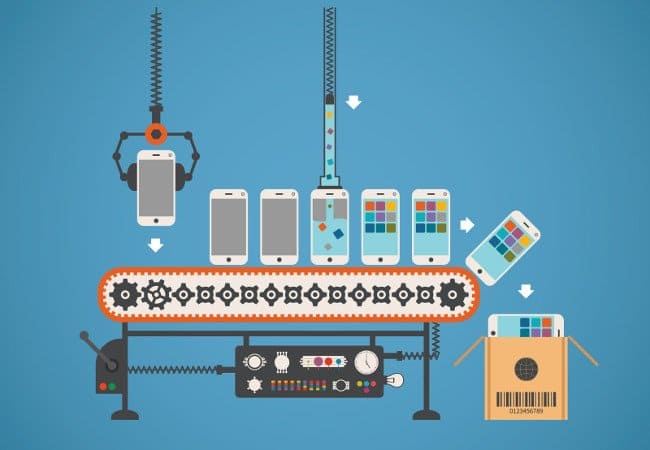The industrial sector is undergoing major transformations. Most of the novelties of modern industry is based on the concept of Lean Manufacturing, or lean manufacturing. In this article, we will explain the definition of this approach, its origin, and the categories into which it divides and show how to put this process into practice within a factory.
Origin of Lean Manufacturing
Despite of being a concept applied in the most modern industries, this term was born in Japan, when was called “Toyota Production System”. The first step came in 1924, when Sakichi Toyoda – founder of Toyoda Teares – created the first automated loom that would stop production if the thread broke, generating a huge reduction in costs with waste.
This was just the beginning of a series of techniques developed in the Toyota Production System to increase the efficiency of the processes applied in the factories. Especially after the Second World War, the concern was to adopt a philosophy that would eliminate any unnecessary expenses, precisely because of the lack of resources in the post-war period.
What is Lean Manufacturing? And how to apply?
The history of the Toyota Production System already hints at what are the pillars that support Lean Manufacturing. It is a management philosophy focused exclusively on the efficiency of processes. In other words, the objective of all actions is to spend the smallest resources possible to produce maximum value with only what is necessary.
In a literal translation, “Lean” means “lean”. In other words, the idea here is to have a better, cheaper and more agile production system. For this, all the waste must be identified and eliminated. Furthermore, it is a method focused on the present: it is necessary to deliver what is needed now, without worrying about adaptations that may need to be made in the future.
Finally, Lean Manufacturing is also about agility. The idea is to put the machines to work and optimize each process while “everything is spinning”, without bureaucracy or waste of time.
If it seems simple from a distance, it is not easy to apply this union of concepts in practice. First, it is necessary to identify where the problems and processes are that do not generate any value for the customer. To do this, it is necessary to study the company’s scenario very well, measure as much data as possible and, of course, join efforts to solve the problems detected.
Another important step to apply Lean Manufacturing in the industry is the debate with employees. Those who are actually present on the production line have more knowledge about opportunities for process improvement. It is important that people also have autonomy and absorb this “lean” thinking.
The 7 Lean Manufacturing Wastes
By now, you should have understood that seeking efficiency and eliminating waste are the key points of Lean Manufacturing. However, where exactly do you find these opportunities for improvement in the production process?
The methodology itself points out 7 “categories” that can be optimized to bring greater value to the customer:
1- Transportation
When any resource – whether equipment or people – is moved unnecessarily, there is a waste of transport. A classic example is moving parts to the wrong place or at the wrong time.
Within the industrial routine, transportation is a fundamental part. This is precisely why this movement needs to be strategically planned and executed.
2- Movement
Unnecessary employee movements are also a type of waste. When the work environment is disorganized, it is common for employees to have to look for a tool, walk around the factory or something.
In this sense, it is worth paying attention not only to the elimination of unnecessary displacements, but even necessary movements can also be reduced and optimized.
3- Defects
Any defect in the product will bring waste to the company: either by reworking the problem or, even worse, in direct impact to the consumer.
In this way, every measure of prevention and continuous improvement will help to optimize the process in the factory.
4- Wait
The waste of waiting time occurs when people (or even equipment) are forced to spend unnecessary idle time waiting for the availability of some other resource.
Workers who need to wait for some order from a manager or sign a document to start a process are an example of this waste.
5- Excessive Production
Producing more than necessary or at a higher than ideal speed will generate an increase in the stock of finished products and, consequently, a waste of excessive production.
If apparently this “stock” does not seem to be a big problem, when looking at it more coldly we realize that it is possible that it will become obsolete or not be sold. Therefore, keeping stock to a minimum for the process to run is the most recommended.
6- Excessive Processing
This category includes processes that do not generate value for the item being produced. For example, unnecessary steps that do not increase the quality of the product or have no perceived value by the customer.
A careful analysis in the operation can identify which are the tasks that can be eliminated in the employees’ daily routine.
7- Inventory
The lack of planning or knowledge of the purchasing department can cause a waste of raw materials. Having a larger inventory than necessary generates higher costs, occupation of free areas and can even hinder other processes.
Efficient purchasing planning and continuous control over this raw material are the best ways to avoid this waste.
Technology as an improvement tool
Identifying these wastes is not always an easy task. It is no coincidence that the Toyota Production System was recognized and studied internationally.
However, today it is possible to rely on technological tools that Sakichi Toyoda did not have in his day. Through them, it is possible to control and monitor in real time the processes carried out in the factory.
Using indoor geolocation technologies, Novidá is one of the companies working in this segment. We believe that Lean Manufacturing can help your company grow much more. Understand how our solution works!
Using indoor geolocation technologies, Novidá is one of the companies working in this segment. We believe that Lean Manufacturing can help your company grow much more. Understand how our solution works!





